Para leer en español, haga clic aquí.
West Mexico is full of color, and to better understand the riotous diversity of this landscape, Rocky Mountain Bird Observatory and the University of Guadalajara have joined forces and received funding from Mexico’s National Forestry Commission (CONAFOR) and the U.S. Forest Service. This project is being carried out in the temperate forests of western Jalisco, east and south of Puerto Vallarta, and in coordination with CONAFOR’s National Forest Inventory. The study’s goal is to determine how the great diversity of species in the region relates to the structure and composition of managed forests and propose a way to incorporate birds into management decisions as indicators of biodiversity and ecosystem health. It’s been a little more than a year since field surveys began and the challenges have been substantial, as well as the achievements and experiences.
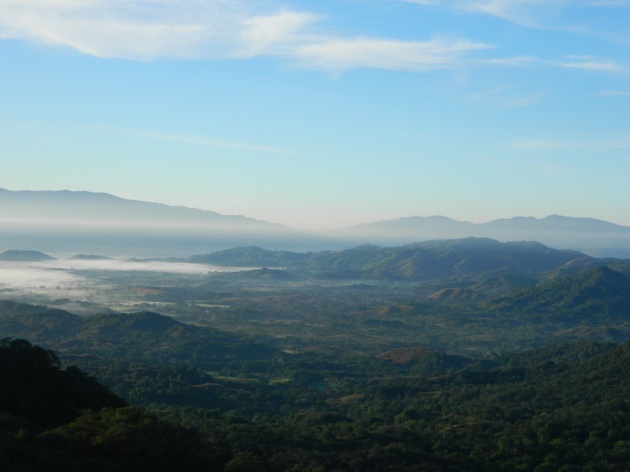
View of the valley and mountains of Villa de Purificación, Jalisco. Photo by Luz Rodríguez Parga.
The field work was done by four biological field technicians, in two teams, with the required experience and skill to identify the great majority of bird vocalizations using a point count survey methodology. Our field excursions, and shared living experiences, generally lasted from five to 12 days. If the survey area met the study criteria and was safe for work, the stay at each site was for three consecutive days, which allowed us to contemplate an infinity of vistas, beautiful sunrises, an average of 50 species of birds per day, kilometers of walking each morning, river baths and, yes, even getting to know how salty your companions like their food.
Normally, the surveys took place between 7:10 a.m. and 11:00 a.m. If we were able to camp nearby, 6:40 a.m. was a good time to wake up. Each team was charged with completing 25 point counts each morning, 12 or 13 per technician. On any given day, with a little luck, we might see parrots, a margay, deer, coati, fox and snakes (though not every technician considered this lucky!).
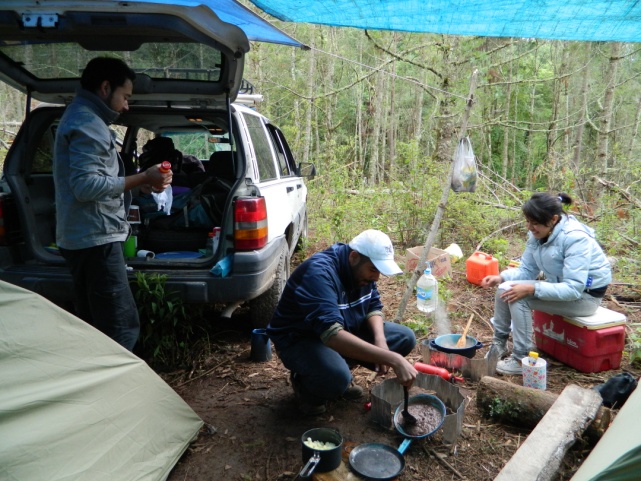
Technicians hide from the rain after conducting point counts near “Pitoreal” (the eponymous local common name of the Pale-billed Woodpecker). Photo by Luz Rodríguez Parga.
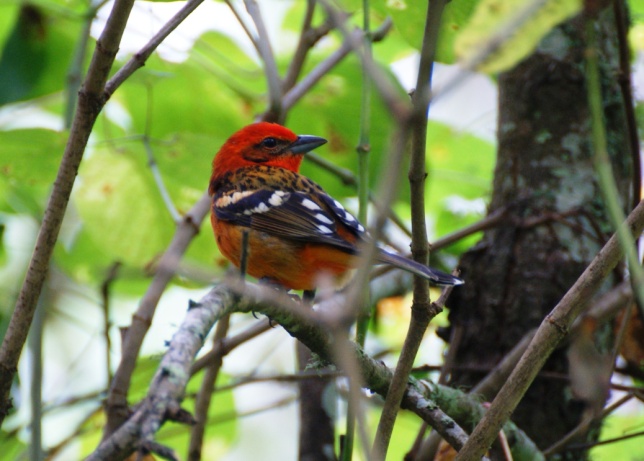
A Flame-colored Tanager. Photo by Ángeles González Martínez.
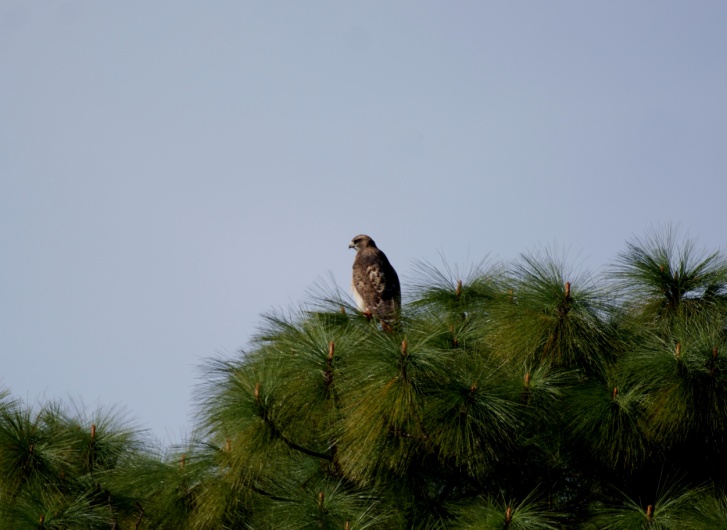
A Red-tailed Hawk enjoys the warm air of the forest. Photo by Ángeles González Martínez.
Help Found in Local Communities
Though we always enjoyed camping, it was quite welcome when the people in nearby communities offered us a space in their homes to sleep, conserve and share food and stories. Since part of our work was usually carried out within their community, it was a great opportunity to talk about the importance of the birds on their land.
“I hope the petirojo (Vermilion Flycatcher) lands in front of you, this is good luck,” said Doña Berta, “but if you see it perched behind you, something bad will happen,” such as a bad fall, a long walk, getting into ticks, eight days without being able to bathe or, perhaps, you will hear mysterious footsteps approaching your campsite in the pre-dawn.
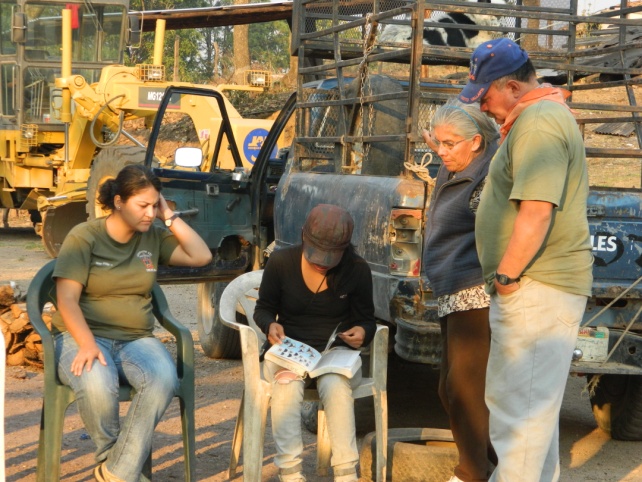
Technicians ask Doña Berta which woodpeckers she has seen in the area. Photo by Luz Rodríguez Parga.
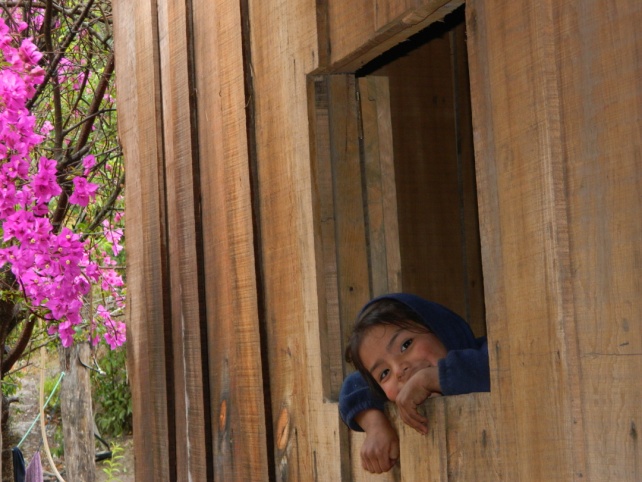
Katy, one of the girls with whom it was possible to share our binoculars and a love for birds. Photo by Luz Rodríguez Parga.
Working in Far-Flung Places
During the field surveys, we had to be on top of our game, simultaneously identifying birds from hundreds of possible species, noting the sex, estimating the distance from the observer and counting flock sizes of birds moving continuously through the canopy. We also had to be able to orient ourselves using a compass and GPS unit (that occasionally did not work in rugged terrain). A few times we had to play the role of rescuers, but fortunately we never made it out of the planning stages before our overdue partner arrived. During this time, the trees became our best confidants and the birds our best advisors.
“Listen, why don’t you do your work here close by?”, “Why not do your study in my ranch?” or “Aren’t you afraid of jaguars?” were some of the questions we got from locals. It always seemed strange to them that we did our work in such far-flung places that were frequently quite difficult to access. At these times we would explain that our study areas were the predefined points of the National Forestry Inventory, and had been chosen so that we could provide CONAFOR the information it needed to classify the health of a forest by the composition and abundance of the bird communities present.
In the afternoons, after eating and resting a bit, we returned with our field partner to characterize and measure the habitat at the points where we had surveyed for birds that morning. Around 6 p.m. we would return to camp ready for a chat or discussion or to simply remain hypnotized by a starry sky or the rising flames from our campfire.
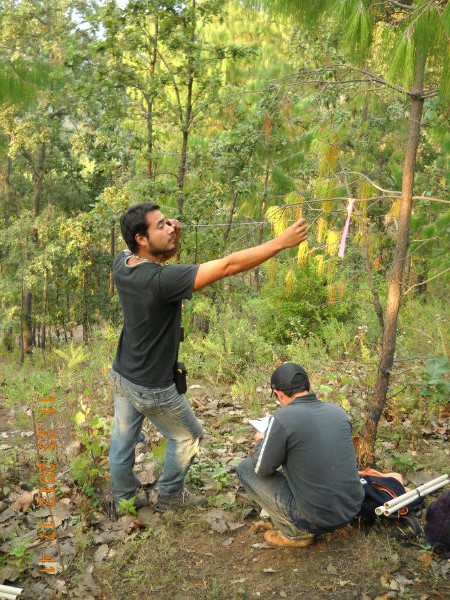
Collecting vegetation data. One technician measures basal area as the other records. Photo by Ángeles González Martínez.
The second and especially third days at a site were easier as we had already learned our way around the forest and established a walking route. When it was time to break camp and move on to another study site, we wondered, “Will we be able to drive within 500 meters or will we have a 3 kilometer vertical climb?”, “Will we see a species new to science?”, “Though thought extinct, rumors remain … might we see an Imperial Woodpecker?”, “Will there be a ranch nearby?” or “Will there be a festival in the town?” These were some of the many unknowns we would ponder while approaching our next site.
To know the behavior of the birds, to listen to their songs, to breathe in the smell of the forest and to feel the peace that nature offers are ample reasons to still want to return to the field after another challenging and physically strenuous outing.
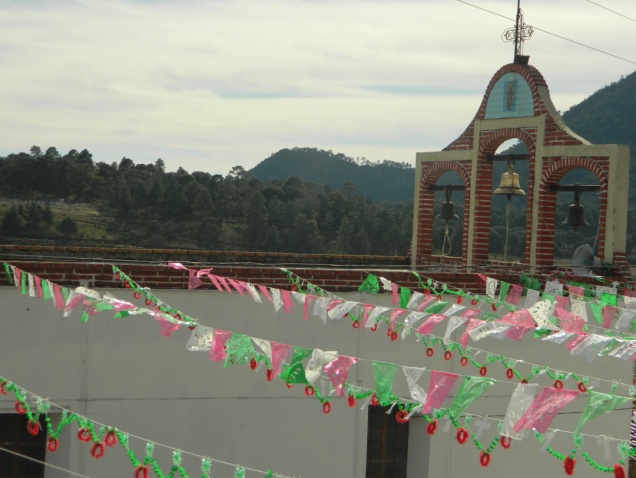
The Fiestas of the 12th of January celebrate the Virgin of Guadalupe in Juanacatlán, in Mascota, Jalisco. Photo by Luz Rodríguez Parga.
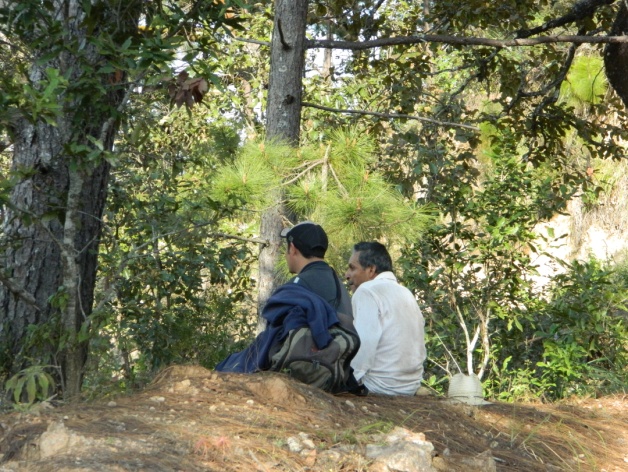
A chat with Don David makes clear that teaching and learning do not only occur in the classroom. Photo by Luz Rodríguez Parga.
Stats and Birds
The surveys in Jalisco, Mexico, were conducted during one breeding season, April to July 2012, and one wintering season, October 2012 to March 2013. Over the two seasons, we’ve detected 195 species and 23,106 total birds and conducted 2,145 point counts. Some interesting species detected include:
- Crested Guan
- Singing Quail
- Collared Forest-Falcon
- Laughing Falcon
- Orange-fronted Parakeet
- Mexican Parrotlet
- Amethyst-throated Hummingbird
- Cinnamon Hummingbird
- Eared Quetzal
- Russet-crowned Motmot
- Smokey-brown Woodpecker
- Ivory-billed Woodcreeper
- Greenish Elaenia
- Grey-collared Becard
- Gray-barred Wren
- Happy Wren
- Orange-billed Nightingale-Thrush
- Ruddy-capped Nightingale-Thrush
- Gray Silky-flycatcher
- Red Warbler
- Green-striped Brush-Finch
- Yellow-winged Cacique
- Elegant Euphonia
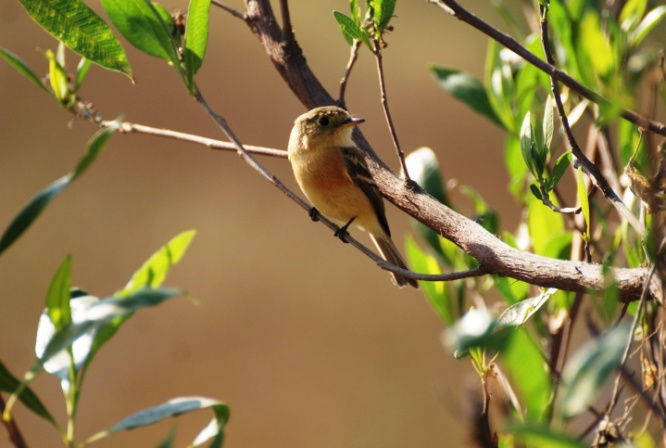
The Buff-breasted Flycatcher, a creature that inspires curiosity. Photo by Ángeles González Martínez.

A White-eared Hummingbird breathes in the sweet smell of nectar. Photo by Ángeles González Martínez.
We would like to thank our friends who helped us enter data, pointed us along the correct paths, who helped us contact landowners and put us in touch with trustworthy people along the way. And without a doubt, we deeply valued the shared moments with the people of the communities we met along the way. We are also thankful for funding from CONAFOR and USFS, as well as the administrative personnel at the Manantlán Institute of Ecology and Conservation of Biodiversity (IMECBIO) and Rocky Mountain Bird Observatory.
~ Luz Rodríguez Parga, Ángeles González Martínez and Juan Loera Casillas, part of the Jalisco field team and our friends from the University of Guadalajara
Visit West Mexico with RMBO!
Would you like to go birding in this scenic area? RMBO will host a tour Jan. 18-24, 2014, in Jalisco, Mexico. RMBO’s Conservation Birding Tours combine world class bird-watching with science-based education to showcase the biodiversity of continentally important bird areas, increase awareness and support local conservation programs. This upcoming tour in Jalisco is geared toward serious nature enthusiasts who enjoy getting off the beaten path, becoming better informed about biodiversity conservation, experiencing local culture, seeing lots of birds – and making a difference!
Spanish version:
Un año de muestreos en campo en el oeste de México: Experiencias de los biólogos de campo
El occidente de Jalisco está lleno de color, y para evidenciarlo el Rocky Mountain Bird Observatory y la Universidad de Guadalajara han reunido capacidades gracias al financiamiento de la Comisión Nacional Forestal (CONAFOR) de México y el Servicio Forestal de los Estados Unidos. El proyecto fue desarrollado en los bosques templados del occidente de Jalisco, específicamente en puntos del Inventario Nacional Forestal (INFyS) de la CONAFOR. Con ello se pretende determinar como la diversidad de especies de aves se relaciona con la estructura y composición de bosques manejados y proponer formas para incorporarlas como indicadoras de biodiversidad y salud del ecosistema. Ha transcurrido poco más de un año desde que se iniciaron los muestreos de campo; los retos han sido bastantes, así como los logros y experiencias ganadas.

Una mirada hacia los valles y montañas del municipio de Villa de Purificación, Jalisco. Foto por Luz Rodríguez Parga.
El trabajo de campo fue realizado por un equipo de 4 técnicos – dos por brigada – con experiencia y capacidades para reconocer el mayor número de vocalizaciones de las aves, ya que la técnica empleada fue la de puntos conteo. Las salidas de campo y convivencia iban de 5 hasta 12 días; si el sitio reunía las condiciones apropiadas para trabajar y era seguro, la estancia por localidad (punto del INFyS) era de tres días consecutivos logrando contemplar infinidad de paisajes, admirar amaneceres, detectar en promedio 50 especies de aves en un día, caminar kilómetros cada mañana, disfrutar del baño en la corriente de un río y conocer la cantidad de sal que ponía a la comida el compañero de brigada.
Normalmente el muestreo se realizaba de las 7:10 am a las 11:00 am, si el área de acampado se había podido localizar cerca del área de trabajo, era buen tiempo despertarse a las 6:40 am. Cada brigada debía completar hasta 25 subestaciones de puntos de conteo por sitio INFyS, se repartía 12 y 13 puntos por observador. Algún día con suerte se logró ver loros, un tigrillo, venados, coati, zorras y serpientes (aunque las serpientes no eran de mucha suerte para algunos técnicos).

Técnicos resguardándose de la llovizna y cocinando después de realizar los puntos de conteo de aves en el paraje “Pitoreal (nombre dado por los pobladores haciendo referencia a Campephilus guatemalensis)”. Foto por Luz Rodríguez Parga.

Piranga bidentata por Ángeles González Martínez.

Buteo jamaicensis. Sintiendo el cálido aire del bosque. Foto por Ángeles González Martínez.
Siempre era buena la actividad de acampar, pero excelente cuando las personas de las comunidades ofrecían un espacio en sus hogares para dormir, conversar, compartir la comida, anécdotas y parte del trabajo realizado en su localidad, teniendo oportunidad de platicar sobre la importancia de las aves dentro de sus localidades.
“Ojala el petirojo (Pirocephalus rubinus) se pare de frente a tí” esto es de buena suerte – conto Doña Berta – “pero sí lo vez perchándose de espalda hacia tí, algo malo te sucederá” tal vez una fuerte caída, largas caminatas, adhesión de garrapatas, durar 8 días sin bañarte o escuchar pisadas misteriosas acercándose al campamento durante la madrugada.

Técnicos preguntan a Doña Berta que carpinteros ha visto en su localidad. Foto por Luz Rodríguez Parga.

Katy una de las niñas con la que fue posible compartir el uso de binoculares y el gusto por las aves. Foto por Luz Rodríguez Parga.
Durante la realización del muestreo de aves se debía mostrar la mejor destreza: identificar especies entre cientos de posibles, sexo, estimar distancia del observador y contar parvadas moviéndose continuamente a través la dosel. Además, mostrar habilidades para no perderse dentro del bosque con ayuda de brújula y GPS (que a veces no funcionaban en terreno escabroso). Algunas ocasiones fue necesario tomar el papel de los rescatistas, afortunadamente solo quedaba en la elaboración de un plan pues a final de cuenta el compañero de brigada lograba aparecer. -Durante todo este tiempo los arboles se volvían los mejor confidentes y las aves las mejores consejeras.
“Oiga ¿pero porque no hacen el trabajo aquí cerca?”, “¿porque mejor no hace el trabajo dentro mi rancho?” o “¿no les da miedo que les salga el tigre?”, eran algunas de las preguntas que hacían las personas de las comunidades, siempre les parecía extraño que el trabajo se realizara en lugares lejanos y frecuentemente de difícil acceso, entonces se les explicaba que los puntos de trabajo eran los puntos definidos por la CONAFOR para hacer el INFyS de México y fueron seleccionados para proveer a CONAFOR la información necesaria para poder clasificar la salud de un bosque por la composición y abundancia de las comunidades de aves encontradas ahí.
Por la tarde, después de comer y descansar un momento se regresaba a visitar las subestaciones donde había sido posible realizar punto de conteo de aves para hacer caracterización y medición del hábitat entre los dos compañeros, regresando al campamento alrededor de las 6 de la tarde dispuestos para una plática y discusión o; simplemente quedar hipnotizados por un cielo estrellado o por las llamas salientes de la fogata.

Realizando el muestreo de vegetación un técnico observa la categoría para estimar área basal y el otro registra. Foto por Ángeles González Martínez.
La segunda y sobre todo la tercera mañana de muestreo eran más fáciles pues ya se había logrado reconocer el bosque y establecer una ruta de camino. Cuando tocaba el turno de levantar campamento y mudarse hacia otro punto del INFyS siempre era intrigante, ¿se podrá llegar hasta 500m en vehículo al sitio de trabajo?, ¿tendremos que caminar 3 km en subida?, ¿alguna especie nueva para la ciencia?, ¿aunque pensado extinto, acaso será posible ver un carpintero imperial?, ¿habrá un rancho habitado cerca?, ¿habrá fiestas en el pueblo?, son incógnitas que aparecían durante el avance de los vehículos para llegar a otro punto.
Conocer comportamientos de las aves, escuchar sus cantos, respirar el olor a bosque, sentir la paz que ofrece la naturaleza son suficientes razones que motivan a regresar al trabajo en campo, aun después de los esfuerzos físicos.

Fiestas del 12 de enero para celebrar a la Virgen de Guadalupe en Juanacatlán, municipio de Mascota, Jalisco. Foto por Luz Rodríguez Parga.

Descansando con Don David y comprobando que la enseñanza y aprendizaje no solamente se da en el salón de clases, San Andrés, municipio de Mascota. Foto por Luz Rodríguez Parga.

Empidonax fulvifrons. Un ser oculto que inspira curiosidad. Foto por Ángeles González Martínez.

Hylocharis leucotis. Respirando el dulce olor del néctar. Foto por Ángeles González Martínez.
Los muestreos en Jalisco, se llevaron a cabo durante una época reproductiva, que abarca de abril hasta julio 2012, y una temporada no-reproductiva, de octubre 2012 hasta marzo 2013. En estos dos periodos, registramos 23,106 aves de 195 especies durante 2,145 puntos de conteo.
Los agradecimientos vas dirigidos a los amigos que ayudaron en la captura de la información, a reconocer caminos, a contactar a los propietarios de los terrenos forestales y personas de confianza; sin duda los momentos compartidos con las personas de las comunidades, también es entrañablemente valorado. Se agradece también por el financiamiento al USFS y a la CONAFOR, así como al personal administrativo del Instituto Manantlán de Ecología y Conservación de la Biodiversidad y al Rocky Mountain Bird Observatory.
~ Luz Rodríguez Parga, Ángeles González Martínez y Juan Loera Casillas, de la Universidad de Guadalajara


